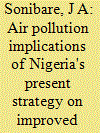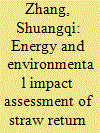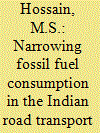|
|
|
Sort Order |
|
|
|
Items / Page
|
|
|
|
|
|
|
| Srl | Item |
| 1 |
ID:
098624


|
|
|
|
|
| Publication |
2010.
|
| Summary/Abstract |
One of the strategies being developed in Nigeria to increase the presently installed electricity generation of 6159 MW to the required 30,000 MW is the adoption of electric thermal plants. An emission factor approach is used in this paper to study the emission of uncontrolled air pollutants from all the existing and proposed thermal plants in the country. Calculations are performed to study the distribution of carbon monoxide (CO), oxides of nitrogen (NOX), particulate matters (PM), sulphur dioxide (SO2), and volatile organic compounds (VOCs). The estimated emissions ranges are 978-24,607, 1635-41,148, 37-924, 19-472, and 11-286 ton/annum for CO, NOX, PM, SO2, and VOCs, respectively. The present locations of these plants across the country are characterized by skewed emission distribution both per capita and across the land. Given the potential environmental and health impacts of these emissions, several measures are suggested to reduce future impacts and assist the country in achieving sustainable development.
|
|
|
|
|
|
|
|
|
|
|
|
|
|
|
|
| 2 |
ID:
166398


|
|
|
|
|
| Summary/Abstract |
The utilization of straw plays an important role in China's sustainable development. Returning straw to fields as organic fertilizer (straw return) and processing straw into straw briquette fuel (SBF) are two of the most promising methods for employing straw; however, there is a lack of information with respect to comparing these two methods. Therefore, a case study was conducted in Heilongjiang Province to estimate the energy and environmental impacts of straw return and the substitution of SBF for rural heating coal. This study aims to provide policymakers with useful information and to encourage rational decision-making regarding the efficient utilization of straw resources. Results showed that both straw return and substituting SBF for rural heating coal could have significant impacts on energy and the environment, while substituting SBF for rural heating coal had advantages over straw return in all aspects. Moreover, substituting SBF for rural heating coal was more acceptable to famers, and thus was easier to promote and could resolve the problem of open straw burning more effectively than straw return. Therefore, greater attention should be paid to SBF utilization, especially in rural areas. Results of this study can also benefit other regions to improve the utilization of straw resources.
|
|
|
|
|
|
|
|
|
|
|
|
|
|
|
|
| 3 |
ID:
117313


|
|
|
|
|
| Publication |
2013.
|
| Summary/Abstract |
Road transportation has contributed to increased emissions of conventional air pollutants and, consequently, to the increase in problems associated with the environment and human health, depending on the type of pollutant and the concentration of it. To support the development of public policies aimed to decrease total tonnes of emissions, we used a bottom-up approach to estimate the amount of air pollutants, such as carbon monoxide (CO), total hydrocarbons (THC), nitrogen oxides (NOx), particulate matter (PM), and aldehydes (RCHO), that are emitted by road transportation in the state of Rio de Janeiro (RJ) from 1980 to 2010. The results from 2010 show that cars are responsible for 55% of CO emissions, 61% of THC emissions, and 93% of RCHO emissions. Due to the use of hydrated ethanol and compressed natural gas (CNG) instead of petroleum based fuels during the period analyzed, 1,760,370 t of air pollutant emissions were avoided. Compared to Brazil, in 2010, RJ had a quantity of emissions per vehicle from 12% (CO) to 59% (PM) smaller than the national average. As strategies to reduce air pollutant emissions, we consider reducing the intensity of use, with a proportional reduction in emissions, and increased the use of biodiesel.
|
|
|
|
|
|
|
|
|
|
|
|
|
|
|
|
| 4 |
ID:
188542


|
|
|
|
|
| Summary/Abstract |
Road transportation accounts for 56% of India's transportation sector's CO2 emissions. Reaching carbon neutrality before 2070 requires the deep decarbonization of this sector. This study assesses the potential of battery electric vehicles (BEV) and fuel-cell vehicles (FCV) as the least-cost pathway toward carbon neutrality. We estimate the future demand for passenger and freight services and evaluate the impact of EV policies using the Integrated Model of Energy, Environment, and Economy for Sustainable Development/Technology (IMED/TEC). The study covers road transport emissions, energy, and air pollution transitions under four scenarios, including reference, low, medium, and high penetration of BEV and FCV, which align with the decarbonization target agreed upon under India's national policy. Results show that the carbon neutrality target would be challenging with BEV alone in road passenger and freight transportation because it is less efficient. Combined penetration of BEV and FCV can reduce air pollutant emissions significantly. Operative implementation of FCV could diminish more than 96% of the total road transport CO2 emissions. The analytical framework also proposes local climate change policies towards a carbon neutrality strategy to escalate the share of BEV and FCV in the Indian road transport sector.
|
|
|
|
|
|
|
|
|
|
|
|
|
|
|
|
| 5 |
ID:
166728


|
|
|
|
|
| Summary/Abstract |
Shipping is a significant contributor to global greenhouse gas (GHG) and air pollutant emissions. This study uses a life cycle assessment to compare emissions from domestic and imported liquefied natural gas (LNG), and heavy-fuel oil (HFO) for marine shipping. The findings show that only high-pressure dual-fuel (HPDF) engines robustly reduce well-to-wake GHG emissions by 10% compared with their HFO-fuelled counterparts. This engine technology is only available for large low-speed engines used in ocean-going vessels (OGVs). For smaller vessels, such as ferries, the current deployment of medium speed low-pressure dual-fuel (MS-LPDF) and lean burn spark ignition (LBSI) gas engines cannot reliably reduce GHG emissions. This is primarily due to the high levels of methane slip from these engines. For air pollution reduction, gas engines are found to be an effective means of reducing nitrogen oxides, sulphur oxides and, particulate matter without any additional engine aftertreatment. The HPDF engines, however, need aftertreatment or exhaust gas recirculation to meet the International Maritime Organization Tier III regulations. Sulphur controls, such as the 2020 act, move to limit sulphur to 0.5% globally. However, this will increase the cost of the HFO used by most OGVs, enhancing the economic case for natural gas fuel.
|
|
|
|
|
|
|
|
|
|
|
|
|
|
|
|
|
|
|
|
|